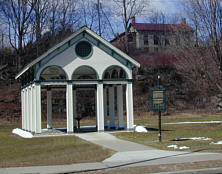SARATOGA SPRINGSNEW YORK |
 |
SARATOGA SPRINGSNEW YORK |
 |
| Saratoga’s
First Resort for Travelers
Called by the Mohawk Indians, “The Medicine Spring of the Great Spirit” now known as the High Rock Spring. The first white man to visit the spring was Sir William Johnson in 1767. Gen. George Washington, Gov. George Clinton and Alexander Hamilton visited Gen. Philip Schuler here in 1783. Erected by Bemis Heights Society of the Daughters of the American Revolution. (Saratoga Spring Marker) |
|
High Rock Spring — The intersection of Rock Street and Maple Avenue is where High Rock Spring is located. The spring has attracted people to this area for centuries. There is a marker at the base of the rock near the spring buildings.
Legend has it that Indians visited the springs as early as 1300. They believed that the spring had medicinal properties and helped one gain strength. They called it the “Medicine spring of the Great Spirit.”
 The
reputation of the spring grew tremendously during the French and Indian War.
After Sir William Johnson was wounded at the Battle of Lake George, he was
carried to the spring by Mohawk Indians. He was fed water from the spring and
his health improved markedly. He was able to make parts of the return trip on
his feet — a miracle attributed to the spring.
The
reputation of the spring grew tremendously during the French and Indian War.
After Sir William Johnson was wounded at the Battle of Lake George, he was
carried to the spring by Mohawk Indians. He was fed water from the spring and
his health improved markedly. He was able to make parts of the return trip on
his feet — a miracle attributed to the spring.
In 1774, the first inn for visitors opened at the spring. In 1777, the Norton family purchased the inn and operated it for over ten years, except for a brief interruption caused by the British invasion from Canada.
As the Revolutionary War came to a close, Philip Schuyler built a plank road from his summer home in Schuylerville to the springs. In 1783, George Washington came to Saratoga to inspect the battlefield and other fortifications in the area. Schuyler brought him to the High Rock Spring along with Alexander Hamilton and Governor Clinton. Washington was so impressed by the spring that he later attempted to purchase land in the area. His attempt was blocked by titles secured by Livingston and Walton.
After the Revolutionary War, the inn was purchased by Alexander Bryan. Bryan was an American spy during the Revolutionary War. Prior to the battles at Saratoga, Bryan entered Burgoyne’s camp in an attempt to figure out the route of the British army. After learning of the British plan, his presence was discovered and he narrowly escaped. He reported his findings to General Gates and the information helped to secure the American victory.
| Bryan
Home
Erected 1832 on this site of the Log Cabin Inn of Alexander Bryan, Revolutionary Scout. (Saratoga Springs Marker) |
|
Dinner in Saratoga Springs — Today, the Olde Bryan Inn, at the corner of Maple Avenue and Rock Street, is the restored inn once operated by Alexander Bryan. The inn is a popular eating establishment in Saratoga Springs and is a recommended spot for dinner.
|
Ellen Hardin Walworth 1832-1915 One of the founders of the National Society Daughters of the American Revolution, October 11, 1890. (Saratoga Springs Memorial) |
|
Congress Park — As you enter the park, you’ll pass a memorial on the left to Ellen Hardin Walworth, one of the founders of the Daughters of the American Revolution. On the right is the Congress Spring, discovered in 1792 by Congressman John Gilman. The spring was later exploited by lumberman and entrepreneur, Gideon Putnam. In 1802, he built a hotel called Union Hall. By 1806, visitors were so numerous, a second hotel was built called Congress Hall. In the late 1800’s, a casino was built. Today, the Casino is a museum and the current home of the Historical Society.
Across Broadway from Congress Park is the Visitor Center. The center is a recommended stop on a longer visit to the area.
A great place to stay is the Gideon Putnam Hotel. It is a brick, Georgian style structure erected in 1935 and is located in the state park. Inside the park are several working springs and a geyser, spouting Saratoga’s famous mineral water. Reservations are a must and can be made at 518-584-3000.
